How to move a $10 billion space telescope 5,800 miles, avoid pirates and see back into the cosmos
The James Webb Space Telescope is scheduled to launch Dec. 18, but first, it had to make it to French Guiana.
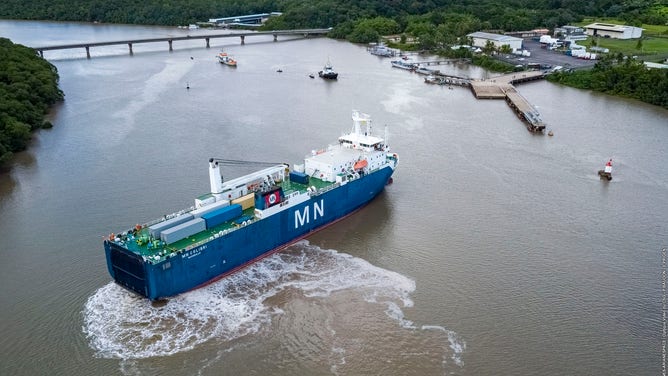
This image shows the arrival of the James Webb Space Telescope to Port de Pariacabo in French Guiana. It traveled from California, through the Panama Canal, aboard the MN Colibri, arriving October 12, 2021. Image credit: 2021 ESA-CNES-Arianespace/Optique vidéo du CSG - JM Guillon
(NASA/ESA)
To make the next great discoveries about our Universe, NASA's James Webb Space Telescope first had to crisscross oceans, avoid pirate theft and travel 5,800 miles undetected.
Decades in the marking, the most powerful space telescope ever created is set to launch Dec. 18 from French Guiana on an Ariane 5 rocket. The 29-foot-tall observatory was built in the U.S. and underwent years of tests to prepare for the intensity of a rocket launch.
Webb is following in the already impressive act of the Hubble Space Telescope, but the two are unique. Webb will look at the Universe in the infrared, whereas Hubble uses optical and ultraviolet. Hubble's successor, once in space, will be much further from Earth, about 1.5 million kilometers.
Webb will be able to see farther back into the cosmos, observing the first galaxies.
Sandra Irish is an aerospace engineer for NASA's Goddard Space Flight Center in Maryland. Her job was to oversee that the telescope could handle the journey to its final destination on Earth. That is no small task for an observatory with 18-gold plated mirrors and a sun shield about the size of a tennis court.
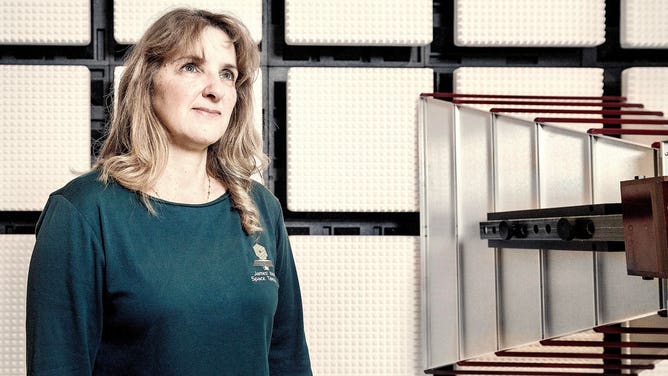
NASA engineer Sandra Irish
(NASA)
"When we travel from point A to point B, we travel by car, we travel by air or sometimes take different trains and different vehicles. But what we're not realizing is that we're getting various motions that are applied to us. And as a person, we can adjust to those motions pretty easily," Irish explained. "But now think of a large, complex observatory that is being packaged and needs to be safely transported, and it has to be able to handle any types of motion that it sees while it's being driven in a car or truck in this case or being on an ocean voyage."
Before its international travel, the telescope's final stop was in California outside of Los Angeles at Northrop Grumman. This is where it was safely packaged into the STTARS container, which stands for Observatory Space Telescope Transporter for Air Road and Sea.
"It's basically a big, gigantic white container," Irish said. "It's the suitcase of the observatory."
According to NASA, STTARS weighs about 168,000 pounds and is 110 feet (33.5 meters) long.
The discrete shipment was unmarked. Irish said they didn't want anyone to tell that the $10 billion space telescope was located inside.
While Irish describes the container as a specialized suitcase, this is no carry-on luggage. Its temperature and humidity controlled, filled with sensors to allow engineers to monitor every bump, wave, or motion that might cause the telescope to move.
After carefully using a crane to place the observatory into its travel container, the move started to the ship.
A 5,800 move incognito
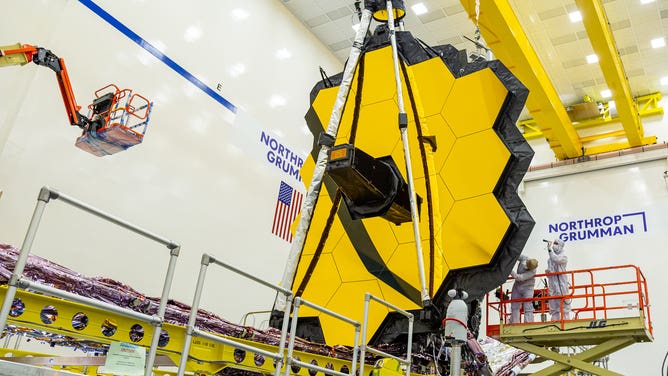
Webb's final tests when the 6.5 meter (21 feet 4 inch) mirror was commanded to fully expand and lock itself into place, just like it would in space. The conclusion of this test represents the team's final checkpoint in a long series of tests designed to ensure Webb's 18 hexagonal mirrors are prepared for a long journey in space.
(Northrop Grumman)
The MN Colibri, a French ship, and its crew were tasked with getting JWST across the world. Every moment was carefully thought out for the sea voyage, down to where the OSTAR container would be on the vessel.
"You feel the waves if you stand in the back of the ship, you can hear the motor going, so you don't want to be at the front of the ship, and you don't want to be at the back of the ship," Irish explained. "The other thing is side to side motion. So we chose the perfect spot in the center of the ship to put our observatory."
Before the observatory started its move, NASA and its partners conducted an experiment voyage to understand what the STTARS container could handle.
"We took the same ship, the MN Colibri, and we conducted a voyage from Hamburg, Germany all the way to Kourou, French Guiana, and we measured the responses that we saw. And then, we correlated that to information that the ship could understand. Then we set our requirements and gave them to the ship."
Before the ship left with Webb, Irish said she spoke to one of two captains on board.
"I explained to the captain that we're carrying $10 billion in his garage," she remembers. "And I explained to him. I said, 'Captain Charles,' I said, 'I really need you to stay away from any high seas.' And he understood exactly what I meant," she said. "So it was our way of communicating to have a very calm voyage. And he says, 'OK, Sandra, I understand very well, and we will do our best to keep the seas calm.'"
There are websites and easily accessible technology to track ships. To avoid any hijinx from pirates or terrorists, the ship's tracking was set to another destination as a decoy. If you looked it up, nothing related to NASA, or its partners, the European Space Agency and Canadian Space Agency, were connected to the ship. It just said "cargo," according to Irish. Even the ship's destination was secret.
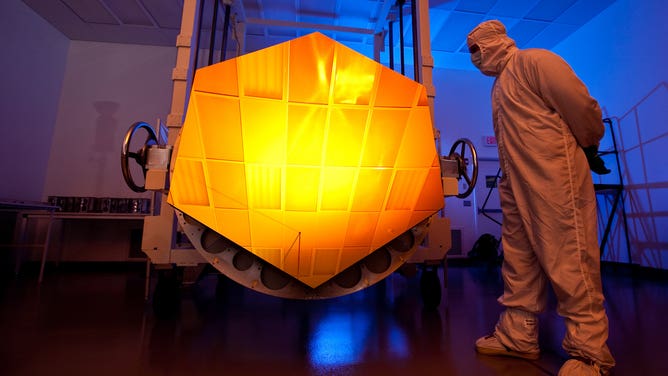
This is a photo of one of the James Webb Space Telescope's primary mirror segments coated with gold by Quantum Coating Incorporated. It's NOT a flight segment, it's the engineering design unit. The photo was taken at BATC by Drew Noel.
(Drew Noel/NASA)
"If you looked up, the MN Colibri. It says it was going back to Nantes, France, which is where the company is based and not to Peru. And we did that on purpose because we're worried about security and any type of terrorism or piracy."
If the ship was intercepted, it would have been hard to break into the STARRS container, said Irish.
"I don't think they really want the observatory, but they would hold it for ransom," Irish said.
To enter the Panama Canal, the tracking had to be turned back on to pass. Irish said she watched the MN Colibri go through the canal via a livestream.
"They didn't have any bumping or any problems, so I was very happy. We got no data from Panama Canal, which was great. So I was watching them," she said. "And then as soon as they got out of the Panama Canal into the Caribbean, they turned off the trackers."
Four NASA engineers rode with JWST to French Guiana for the 5,800-mile journey. Irish monitored every motion the container might have felt remotely and was in constant communication with the team on board.
"They sent data to my team and I to evaluate and said, 'Sandra, should we go? We've seen certain levels of ocean waves. Should we go? Should we wait? What should we do?' So we reviewed it very quickly, sent back our results, and said, 'This is fine, you're going to be OK. Just go ahead.' So they went through the Panama Canal, which was kind of exciting," she said.
'They made it:' An emotional arrival
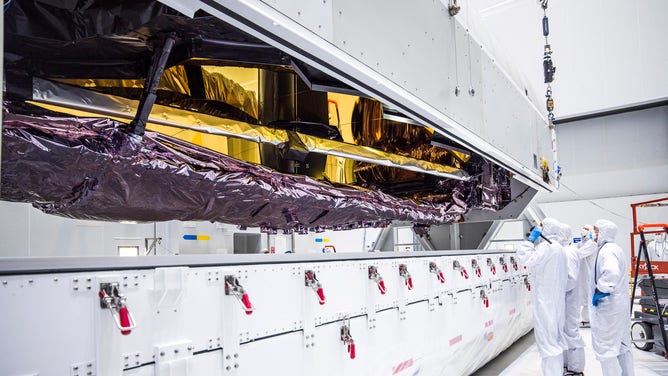
This image shows the James Webb Space Telescope being taken out of the special container in which it was transported to Kourou.
(NASA)
After a 17-day voyage, Webb arrived on Oct. 12 to Port de Pariacabo in French Guiana.
"When they when we got to the port in Kourou, we walked up and asked our engineers came off the ship. And I just gave him a big hug, and I was almost I was in tears. I was just so overwhelmed by the fact that they made it," Irish said.
They then had two days for the STARRS container with Webb to be offloaded and to open it. Irish said it was very emotional seeing the observatory mirrors intact. When she spoke to FOX Weather a few days after the spacecraft was unpacked, it was still undergoing inspection.
For Irish, she will feel a moment of relief not after James Webb Space Telescope successfully launches on Dec. 18 but about six months later when the first image from space comes back sometime in summer 2022.
She's also excited about the discoveries to come.
"I'd like to see if there are any planets out there that have any forms of life that we can identify with and understand," Irish said. "The scientists are on this program are amazing. I know they're going to find some really amazing things."